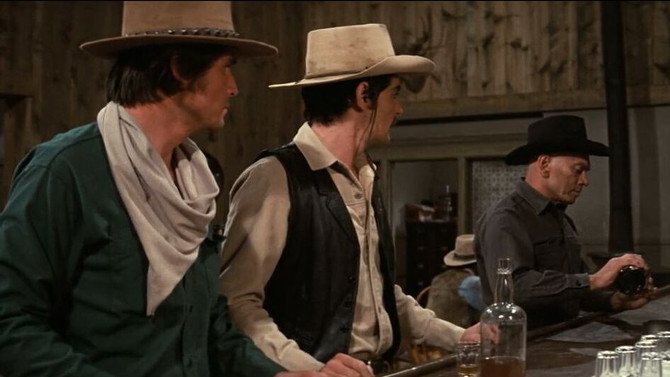Many of you have probably heard of, and may be watching, HBO’s stellar hit show, Westworld. An intriguing premise to say the least, quite a few people do not realize that it is actually based on a 1973 movie of the same name, written and directed by famed novelist Michael Crichton – his first foray into the world of film making.
Set in the not so distant future, this sci fi flick is infused with a classic western twist, as guests head to an amusement park to live out their fantasies in one of three worlds (Roman World, Medieval World and of course, Westworld). With a hint of being a precursor to a dystopic world, we are introduced to our two leads, first time attendee Peter Martin (Richard Benjamin) and his more experienced friend – at least, in relation to the very realistic park, John Blane (James Brolin), in a spacious, futuristic plane on their way to the locale.
The quasi-resort, made up of intricate sets with human-like robots that simulate the feeling of being in the old west, allows visitors to explore nineteenth century shady saloons, sultry brothels, the steamy desert, and everything else a frontier town had to offer back in the day. Each robot is programmed with a specific purpose – some are seductive prostitutes, others, cowardly townsfolk, while one captures the essence of an ornery, quick-draw gunslinger (Yul Brynner). In many ways a take on his own character in The Magnificent Seven, Yul Brynner spoofs his hero, turning him into a menacing villain that looks so much like the beloved Chris from the 1960 feature.
As the pair settle into their modest rooms in a hotel, Peter feels a little cheated by its lack of hominess – John must remind him that that’s kind of the point (things in the old west were not comfortable). Grabbing a drink at the bar, this is the first time Peter and the gunslinger meet. The confrontation leads to a quick draw, with the guest always coming out on top (the designers of the human-like machines have even discovered a way for them to bleed as if it were real).
Also taken behind the scenes, we see the technicians and designers ruminating over certain glitches that have been cropping up in many of their intricate machines. This is actually the first film that features a reference to a computer having a virus.
When things do go wrong, they turn quickly. With Peter and John located in a place that is packed with guns, knives and dangerous, evil-eyed individuals, it does not bode well for them. Will they be able to outsmart the rebelling robots, or will they be shot down in wild west fashion?
An intriguing concept that has since led to a far more in depth show, Crichton develops a film with a multi-tiered message. The most visible warning is the fear of developing technology that is too sophisticated; artificial intelligence that can revolt and overpower its own creators. We see this in Brynner’s gunslinger. Crichton and his team were the first to utilize digital image processing in film – highlighting the automaton’s enhanced vision, which picks up heat signatures at even extended distances, so much better than the human eye. The second cautionary alert, which can often get lost in all of the AI mayhem, is corporate greed. When we join a meeting of the men who run the high-end resort, they know things are malfunctioning, though, instead of closing the retreat and fixing the many problems, they decide to keep the place going, attempting to repair the glitches as they continue to rake in the cash. Like the androids when they turn, these higher ups care not for those living their fantasies (which quickly transition to nightmarish horror) in these worlds, though they are completely culpable compared to the robots they created and are now malfunctioning.
Another interesting connection is that in many ways this is a precursor to Crichton’s Jurassic Park. Dealing with many of the same themes, it too is about an unorthodox tech-centric amusement park where things go horribly wrong – also by way of power failure. Also influential in other ways, John Carpenter based his iconic horror character, Michael Myers (in Halloween), on Yul Brynner’s gunslinger – a seemingly indestructible figure. Likewise, Arnold Schwarzenegger looked to this character as a basis for his memorable turn as the Terminator. For those Simpsons fans out there, you will also recall the 1994 episode: The Simpsons: Itchy & Scratchy Land – at one point, the line “where nothing can possibly go wrong” illuminates Westworld’s original tagline.
A fascinating perspective on the future, Westworld is an engaging feature. Though it will likely not compute for people obsessed with the modern television series, its flashes of the Roman and Medieval worlds add a nice, varied change to the story. Actually, the estate of silent comedy star Harold Lloyd was used for some of the sequences. A visionary story that has had long reaching appeal and influence, it is most definitely worth a watch. So, put on your cowboy boots, poncho and Stetson, and gallop into Westworld to see the fiery reflection in ‘their’ human-like eyes.


